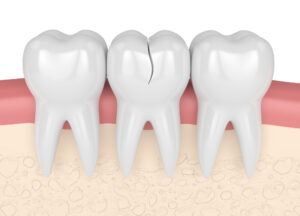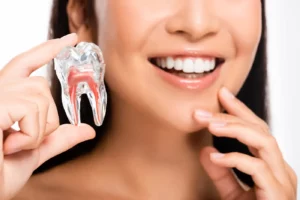Crowns are synthetic caps, usually made of a material like porcelain, placed on the top of a tooth. They are typically used to restore a tooth’s function and appearance following a restorative procedure such as a root canal. When decay in a tooth has become so advanced that large portions of the tooth must be removed, crowns are often used to restore the tooth. Crowns are also used to attach bridges, cover implants, prevent a cracked tooth from becoming worse, or an existing filling is in jeopardy of becoming loose or dislocated. Crowns also serve a cosmetic use, and are applied when a discolored or stained tooth needs to be restored to its natural appearance.
Procedure: A tooth must usually be reduced in size to accommodate a crown. A cast is made of the existing tooth and an impression is made. The impression is sent to a special lab, which manufactures a custom-designed crown. In some cases, a temporary crown is applied until the permanent crown is ready. Permanent crowns are cemented in place.

What is a dental crown?
A dental crown is a full coverage restoration that sits over a tooth (think of it like a winter hat covering a person’s head). A crowns function is to restore a tooth back to function, shape and most importantly, strength. A crown is indicated when a tooth has a crack or is broken, has a root canal, has a large filling that is contracting away from the natural tooth margins, a front tooth is discolored or misshapen, can close gaps if front teeth have gaps, or to restore a dental implant.
Types of crowns:
Zirconia
: Zirconia is a tooth-colored material we recommend for back teeth (your premolars and molars). Zirconia offers tooth colored esthetics plus incredible strength, in fact Zirconia has 10 times the strength as our natural enamel enabling it to handle any chewing load and be incredibly fracture resistant.Layered Zirconia
: Layered Zirconia is Zirconia layered with porcelain. We recommend these for front teeth if you are a heavy clencher or grinder. This combines the strength of Zirconia with the esthetics of porcelain.Emax
: Emax crowns are recommended for front teeth if you are not a heavy clencher or grinder. The esthetics Emax offers are unmatched, this material allows translucency similar to our natural front teeth, in addition to durability.PFM
: Porcelain-fused to metal (PFM) crowns are metal crowns with porcelain layered on top of the metal. Ever see someone with a metal color at the bottom of their teeth near their gumline? Likely they have a PFM crown. PFM crowns used to be very popular but have fallen out of fashion as the strength and esthetics offered by Emax and Zirconia crowns have increased in popularity.Gold
: These are still an option! Ask your dentist if you are interested in gold. Gold options are white gold, or yellow gold.Dental Crown Process steps:
A dental crown is a 2 appointment process. First appointment we will prepare the tooth for the crown by removing any damaged tooth structure and reshaping the tooth so the crown can fit on top without affecting your bite.
Next, we will scan your mouth and send the scan to the lab- just ask if you want to see the scan of your mouth, most patients think it’s cool! After the first appointment you will leave the office in a temporary crown.
About 1-2 weeks later depending on the material you choose; you will return to the office so the permanent crown can be cemented.
After care for a Dental Crown
After care for a dental crown is the same as a natural crown, brush your teeth at least twice per day (gently), floss daily, and see your hygienist twice per year for a professional cleaning. Maintaining good oral hygiene is still important for teeth with crowns because the natural tooth structure remaining can still develop decay if not properly cared for.
Dental Crown vs. Dental Implant
Dental crowns are meant to protect your natural teeth, while implant crowns are meant to restore implants (enable you to chew on your implant). A dental crown is cemented onto your tooth, while an implant crown is often screwed into an implant.
Dental Crown Risks
Dental crowns are great alternatives to restorations because they are biocompatible and unlike filling material, the crown and most cements are BPA free. However, risks remain in any dental procedure. Risks associated with crowns include damage to the tooth or surrounding teeth during the procedure, allergic reaction to materials during procedure or in the cement, loss of crown.
Frequently Asked Questions
How are Dental Bridges created?
Dental Bridges can be used to create a lifelike replacement for a missing tooth. This is done with bridgework, which spans the space of the missing tooth and requires at least three crowns. Two of those crowns will be placed over healthy teeth on either side of the missing tooth; these healthy teeth are referred to as abutment teeth. The two crowned abutment teeth become supports for a third crown placed in between them; that third crown is referred to as a pontic. If more than one tooth is missing, more crowns will be needed to bridge the gap in between the abutment teeth. The number of abutment teeth necessary to replace missing teeth is influenced by the number of missing teeth, the size and length of the abutment tooth roots, the amount of bone support each abutment tooth has, as well as where in the mouth the missing tooth is located. For example, if you have three missing teeth, four abutment teeth may be necessary, thereby creating a seven-tooth bridge. Engineering and designing of the bridge requires an understanding of how to replace teeth, as well as the biology of the supporting gum and bone tissue.
How long do crowns last?
A crown can last forever if cared for properly. Make sure to brush at least twice per day, floss daily and see your hygienist twice per year for a professional cleaning. Sometimes if you are a heavy clencher or grinder, just like natural teeth can break a crown may fracture and need replacement. Similarly, if the natural tooth structure remaining under the crown gets decay, the crown may also need replacement.
How Do I Care for my Crowns & Bridgework?
Crowns and bridgework require the same conscientious care as your natural teeth. Be sure to brush and floss between all of your teeth — restored and natural — every day to reduce the buildup of dental plaque. When you have crowns, it is even more important to maintain your regular schedule of cleanings at the dental office. Avoid using your teeth as tools (to open packages, for example). If you have a grinding habit, wearing a nightguard would be a good idea to protect your teeth and your investment.
Do dental crowns hurt?
Your dentist will make sure to get you numb so you do not feel the procedure. Sometimes post op soreness can occur for a few days as your mouth gets used to the new crown.
How much are dental crowns?
The cost of a dental crown varies based on type of crown and your insurance coverage. Don’t have insurance? No problem! Call us and ask about our in-house insurance plan. Not interested in our in-house insurance either? No problem, we have flat rates for uninsured patients as well. We also accept Care Credit and multiple other payment plans.
What Our Patients Say...
Dr. Zrik is the very best dentist that I have ever had. I would give this practice 10 stars if that were possible. He genuinely cares about the patient 110 %.
Everyone on the staff is always so kind and professional, it’s fabulous.
His work is exceptional
Steve F.
Dr. Zrik is one of the best dentists! I used to have such a large fear of dentists and ever since I started coming to artistic, I feel at ease. They do their best to work with your fears and get a plan together to get your dental health back to where it should be!!!!!
Heather S.
I love this practice! Prior to visiting Artistic, it had been a very long time since I had been to the dentist. Everyone here is extremely kind and welcoming. I felt safe and the providers proved to be amazing. My exam was very quick and efficient. I had a wisdom teeth extraction that went very well and also extremely efficient. Could not be happier
Malhia G.
My family and I have been coming here for years. The staff really care about your oral health and are always punctual and professional. Rosa is the best hygienist, she is very gentle and has a warm personality that makes getting my teeth cleaned a wonderful experience to look forward to. Dr. Revoir and Dr. Z always take their time to answer any questions I might have. I highly recommend this dental office.
David L.
Just a superb Dental experience. The staff and Doctors treat you like you’re their only Client. They have a membership that reduces cost of services by a substantial amount. They’re open weekends. Very caring people. I’ve been a client for nearly ten years and have never been happier. If you’re scared of Dentists, these people will take your fear away. They truly care about your comfort and well-being.
WhisperJet A.
I moved here not that long ago and found this office on google. I have to say I am very impressed. My appt was timely I did not have to wait for forever in the waiting room. The staff was very friendly and accommodating in a genuine way. The exam was through and they explained everything to me so it was easy to understand. Let’s be honest most people don’t like going to the dentist, but my experience here was as painless as this type of thing can be. Will definitely be using this as my new dentist!
TheCreativeJr
Personalized and high quality orthodontic care that you deserve

Latest Blogs

Restore a Tooth’s Function with Crowns or Bridges
When you have lost a tooth or when it is severely damaged, it is important to restore its function as soon as possible. One way

Cracked Tooth and Broken Teeth Treatment in Denver CO
If you are experiencing pain from a cracked tooth, don’t delay in seeking a broken teeth treatment in Denver, CO. See a dentist as soon

What Are Dental Veneers?
Dental veneers are a type of dental restoration that covers the tooth’s front surface to improve its appearance. Veneers can be made from diverse materials,

Beautiful Smile: How Professional Teeth Whitening Treatments Work
Did you know that tooth whitening is one of the most popular cosmetic dental procedures performed today? In fact, according to the American Academy of
Schedule your appointment now
Contact Us
Please contact us with any questions that you may have and a staff member will get back to you shortly.
- Monday:
- 8:00am-4:00pm
- Tuesday:
- 8:00am-4:00pm
- Wednesday:
- 8:00am-4:00pm
- Thursday:
- 8:00am-4:00pm
- Friday:
- 8:00am-4:00pm
- Saturday:
- By Appointment
- Sunday:
- CLOSED
Areas and Zip Codes We Serve
- Hampden
- Hampden Heights
- Hampden South
- Southmoor Park
- Goldsmith
- Virgina Village
- Kennedy
80210 80014 80111 80113 80121 80224
- Get on I-25 S from Champa St and W Colfax Ave(1.9 mi)
- Follow I-25 S to CO-30 E/E Hampden Ave. Take exit 201 from I-25 S (8.4 mi)
- Continue on CO-30 E/E Hampden Ave to your destination (0.9 mi) Artistic & Family Dental 3540 S Poplar St #301, Denver, CO 80237
- Get on I-25 N(2.6 mi)
- Follow I-25 N to CO-30 E/E Hampden Ave in Denver. Take exit 201 from I-25 N (8.6 mi)
- Continue on CO-30 E/E Hampden Ave to your destination (0.7 mi) Artistic & Family Dental 3540 S Poplar St #301, Denver, CO 80237











